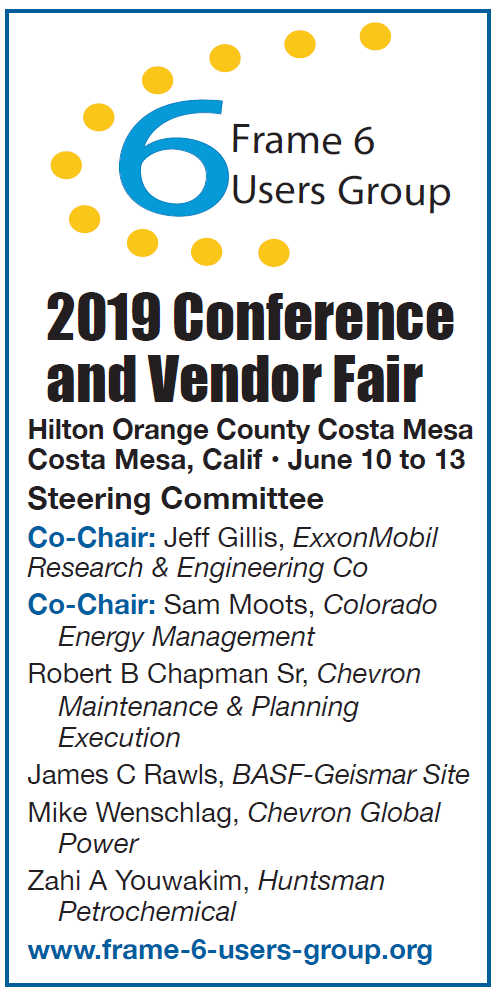The main technical program at Frame 6 meetings begins at 8 a.m. Tuesday morning (June 11 in 2019), following Monday’s engine familiarization workshop and welcome reception and dinner. Roundtable discussions led by members of the steering committee and one of the two invited vendor presentations fill the first-day program until the vendor fair and reception at 5 p.m. The second vendor presentation and remaining discussion topics are on the Thursday morning program; adjournment is at noon, then lunch. Wednesday is GE Day.
Safety is the first discussion topic. That roundtable is led by Co-chair Jeff Gillis, whose position as gas-turbine technology lead for ExxonMobil’s frame gas-turbine fleet worldwide gives him a global perspective on this subject of importance to all attendees. OSHA is not global and America does not have all the answers.
Gillis’ first slide at the 2018 meeting was designed to stimulate thinking aided by morning coffee. He put up a list of possible topics in three categories to get the discussion rolling, including:
 General
General
- Life-saving rules.
- Compartment entry.
- Safety systems
- Hazardous-gas detection.
- Fire suppression.
- Maintenance
- Fall protection and PPE (Personal Protective Equipment).
- Scaffolding and access.
- Safety professionals and other personnel.
- Inlet filter house fire prevention and escape.
- Rescue considerations.
- Fuel-nozzle failures resulting in a casing breach.
One of the users in attendance thought “life-saving rules” at the top of the list was a good place to start, suggesting immediate removal from the site of anyone working without a LOTO (Lock Out/Tag Out) permit, engaging in horseplay, walking under a suspended load, not observing rules pertaining to electrical isolation, as well as other infractions. Others agreed.
Compartment entry when the unit is operating always generates discussion among users; opinions differ. On the one hand it’s much easier to find leaks and troubleshoot when the unit is in service; on the other, there are hazards in doing this.
European gas turbines trip if the compartment door is opened while the unit is operating, the group was told. GE claims opening compartment doors violates the ventilation scheme. Some units trip on low ventilation air flow because air escapes from the door rather than exiting via the ventilation ductwork.
While the consensus view is that a compartment entry protocol is site-specific, the discussion revealed many users are trying to minimize, if not eliminate, access with the GT in service. Ideas offered: Install hazardous-gas detectors in the compartment to warn of fuel-gas leaks. Retrofit armored windows in package doors and floodlights inside the compartment to allow visual checks from outside. Provide access to important operating data outside the package.
Another idea offered is to check for leaks when the unit is on crank. One user went beyond this, saying you can introduce enough air into the system to leak-check with the unit offline.
Trip reduction worked its way into the discussion because 6Bs are installed at many industrial plants to provide steam, and loss of an engine might upset a process that must run continuously. It was said that the OEM now has a package to alarm rather than trip for some operating conditions. This enables operators to assess the situation and decide what to do. The number of trips related to a single event also has been reduced.
Attendees were warned about the hazards of standing directly in front of a door being opened. Also noted was the need to properly close the compartment door after exiting; there’s not much protection from CO2 if the door is ajar.
The possible dangers associated with tying-off when working on top of the turbine was another topic. Fall protection lines can get tangled and cause injuries—possibly ones more severe than an actual fall. Railings have been installed in some cases. A few users reported having tie-off exemptions during outages for work on top of the turbine.
Having a safety professional assigned during outages was suggested. Use of bump caps in place of hard hats was recommended for work inside the generator stator.
The possibility of a fire at the turbine inlet is a real concern to many because it can consume the filter house in a matter of minutes trapping anyone inside if there’s no way to exit safely on both sides. Safety tip: Ban the use of halogen lights in the filter house, near evap media, etc. One user mentioned an incident involving the use of halogen lighting when an oil sump was being cleaned out. A lamp came into contact with oil-soaked rags, creating a large amount of smoke in a confined space.
There’s a vast amount of safety-related information readily available to owner/operators wanting to improve their procedures to best-in-class. You might want to begin your research on the CCJ website in the search bar above where you can find best practices submitted by colleagues over the years.
For the Frame 6 specifically, Gillis prepared a slide of 6B user-forum safety threads, several slides describing more than 30 Technical Information Letters focusing on 6B safety concerns issued by the OEM (TIL 1700, for example, “Potential Gas Leak Hazard During Offline Water Washes”), and content summaries of four GE Product Service Safety Bulletins issued by GE.
Some material pertinent to 6B owner/operators goes beyond the basic engine. One example, PSSB 20161220, “GT Upgrade Impact on HRSG,” presents the experience of an owner that learned a GT upgrade had been implemented without sufficient evaluation of the safety impacts on the boiler. Specifically, the new steaming capacity was greater than the nameplate rating and the relieving capacity of the existing safety valve.
This is a serious concern, but don’t expect to get an in-depth HRSG discussion going at a meeting focused on gas turbines. For that you need to attend the annual HRSG Forum with Bob Anderson. Next conference: July 22-25 in Orlando.





